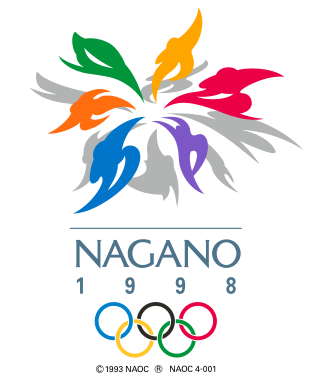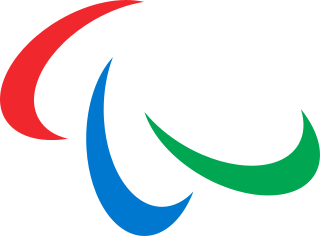Related Research Articles

The 1998 Winter Olympics, officially known as the XVIII Olympic Winter Games and commonly known as Nagano 1998, was a winter multi-sport event held from 7 to 22 February 1998, mainly in Nagano, Japan, with some events taking place in the nearby mountain communities of Hakuba, Karuizawa, Nozawa Onsen, and Yamanouchi. The city of Nagano had previously been a candidate to host the 1940 Winter Olympics, as well as the 1972 Winter Olympics, but had been eliminated at the national level by Sapporo on both occasions.

The 1994 Winter Olympics, officially known as the XVII Olympic Winter Games and commonly known as Lillehammer '94, was an international winter multi-sport event held from 12 to 27 February 1994 in and around Lillehammer, Norway. Having lost the bid for the 1992 Winter Olympics to Albertville in France, Lillehammer was awarded the 1994 Winter Games on 15 September 1988, two days before the 1988 Summer Olympics opening ceremonies at the 94th IOC Session in Seoul, South Korea. Due to the calendar changes made in 1985, this was the only time that the Winter Olympics took place two years after the previous Winter Games, and the first to be held in a different year from the Summer Olympics. This was the second Olympic Games of any type hosted in Norway — the first being the 1952 Winter Olympics in Oslo — and the fourth Olympics overall to be held in a Nordic country, after the 1912 Summer Olympics in Stockholm, Sweden, and the 1952 Summer Olympics in Helsinki, Finland. Until 2022, Lillehammer is the northernmost city ever to host the Olympic Games and also the smallest. This was the last of three consecutive Olympics held in Europe, with Albertville and Barcelona in Spain hosting the 1992 Winter and Summer Games, respectively.

The 1984 Winter Olympics, officially known as the XIV Olympic Winter Games and commonly known as Sarajevo '84, was a winter multi-sport event held between 8 and 19 February 1984 in Sarajevo, Yugoslavia. It was the first Winter Olympic Games held in a Slavic language-speaking country, as well as the only Winter Olympics held in a communist country before the 2022 Winter Olympics in Beijing, China. It was the second consecutive Olympic Games to be so held, after the 1980 Summer Olympics in Moscow, Russian SFSR, Soviet Union.

The 1994 Winter Paralympics, the sixth Paralympic Winter Games, were held in Lillehammer, Norway, from 10 to 19 March 1994. These Games marked the second time the Paralympic Winter Games were held in the same location as the Winter Olympics and with the first with the same Organizing Committee, a tradition that has continued through an agreement of cooperation between the International Olympic Committee (IOC) and the International Paralympic Committee (IPC). Ice sledge hockey, which became an immediate crowd favorite, was added to the program.

The 1998 Winter Paralympics, the seventh Paralympic Winter Games, were held alongside the Winter Olympics in Nagano, Japan from 5 to 14 March 1998. They were the first Paralympic Winter Games to be held outside Europe. 571 athletes competed in Nagano; as 2022 it remains the highest number of athletes competing at any Winter Paralympics.

The 1984 Winter Paralympic Games were the third Winter Paralympics. They were held from 14 to 20 January 1984 in Innsbruck, Austria. They were the first Winter Games organized by the International Co-ordinating Committee (ICC), which was formed on 15 March 1982, in Leysin, Switzerland. These Games were accessible for all athletes with cerebral palsy. Three sports were contested: alpine skiing, cross-country skiing, and ice sledge speed racing. The most successful athlete was German alpine skier Reinhild Moeller, who won 3 gold medals and 1 silver medal. The Games, then known as the 3rd World Winter Games for the Disabled, were fully sanctioned by the International Olympic Committee (IOC).

The 1988 Winter Paralympic Games were the fourth Winter Paralympics, held again in Innsbruck, Austria. These were the last Winter Paralympics to be held in a separate location from the Winter Olympics. Beginning in 1992, the Olympics and the Paralympics were held in the same city or in an adjacent city. These Paralympics were not held at the same Olympic venue in Calgary, Canada, because of financial and recruiting difficulties. A total of 377 athletes from 22 countries took part. The USSR competed for the first and only time. Sit-skiing was introduced as another event in both the Alpine and Nordic skiing competitions. Other sports were biathlon and ice sledge speed racing. Ice sledge speed racer Knut Lundstroem from Norway was the most successful athlete, winning four gold medals in the 100m, 500m, 1000m and 1500m events.

Vikingskipet, officially known as Hamar Olympic Hall, is an indoor multi-use sport and event venue in Hamar, Norway. It was built as the speed skating rink for the 1994 Winter Olympics, and has since also hosted events and tournaments in ice speedway, motorcycle speedway, rally, association football, bandy, ice sledge speed racing, flying disc and track cycling. The arena is also used for concerts, trade fair and the annual computer party The Gathering. It is the home arena of Hamar IL bandy team. The venue is owned by Hamar Municipality, and along with Hamar Olympic Amphitheatre is run by the municipal Hamar Olympiske Anlegg. Vikingskipet has a capacity for 10,600 spectators during sporting events and 20,000 during concerts.

The United Kingdom of Great Britain and Northern Ireland competed at the 2006 Winter Paralympics held in Turin, Italy. The team was known by it shortened name of Great Britain, for identification purposes.
The first IPC Ice Sledge Hockey World Championships was held March, 1996 Nynäshamn, Sweden. Participating countries: Canada, Estonia, Japan, Norway, Sweden and United States. Japan made its debut at the World Championship.
Ice sledge speed racing at the 1994 Winter Paralympics consisted of eight events, four for men and four for women.

Iceland made its Paralympic Games début at the 1980 Summer Paralympics in Arnhem, where it fielded thirteen athletes, who won two medals. Since then, the country has competed in every edition of the Summer Paralympics.

Norway has participated in every edition of both the Summer and Winter Paralympics, except the second Summer Games in 1964. It was one of the seventeen countries to take part in the inaugural Paralympic Games in 1960 in Rome, where it sent a delegation of eleven athletes. Norway was the host country of both the 1980 Winter Paralympics, in Geilo, and the 1994 Winter Paralympics, in Lillehammer.
Helge Bjørnstad is a Norwegian ice sledge hockey player.
Ice sledge racing is a Paralympic sport where contestants use a lightweight sledge and propel themselves using two poles. As a modern organized sport, it was available as a Paralympic sport between 1980–1988 and 1994–1998.
Bente Kristine Grønli was a Norwegian disability athlete who participated in the Paralympic Winter Games once and Paralympic Summer Games three times for Norway. She has won a total of 10 medals in swimming and ice sledge speed racing. She participated in several sports, but it was swimming that was her favorite. Bente worked as a sport science consultant at the Norwegian Handicap Sports Association for 15 years.

France competed at the 1980 Winter Paralympics in Geilo, Norway. 21 competitors won 3 medals, including 1 gold, 1 silver and 1 bronze. France finished 9th in the medal table.
Lene Tystad is a Norwegian wheelchair curler and ice sledge speed racer.
Anne Mette Samdal is a Norwegian wheelchair curler and ice sledge speed racer.
Karin Randi Endsjø is a Norwegian ice sledge racer. She won 1 gold medal, 2 silver medals and 1 bronze medal at the 1984 Paralympic Winter Games. She received a 2009 Erling Stordahl's award.
References
- ↑ "Atle Haglund, medieyndling i Paralympics" (in Norwegian). Norwegian News Agency. 13 March 1998.
- ↑ "Atle Haglund". Paralympic.org. International Paralympic Committee.